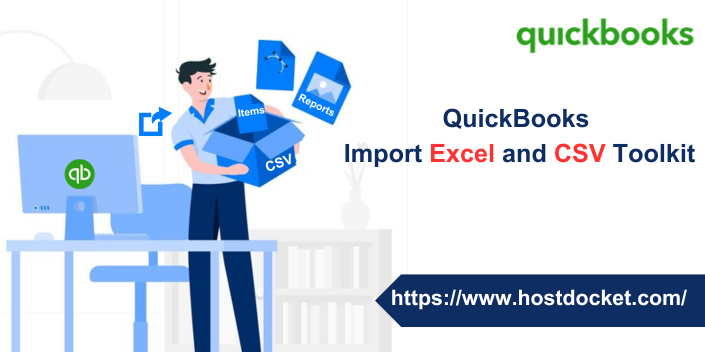When you use online banking, the transactions are recorded. And to download these transactions, a CSV file is required. A CSV file is basically used to import online banking transactions into QuickBooks. You can import CSV files that include bank transactions, general journal entries, accountant’s changes, and batch transactions in QuickBooks. In order to import CSV files, you need to start installing QuickBooks Import Excel and CSV toolkit. To make the import process easier for you, here we are with this segment sharing the complete details as to how to install QuickBooks import Excel and CSV toolkit and how to import CSV files.
Thus, to learn further, stick around till segment till the end. You can also connect with our technical support team at +1-888-510-9198, and we will provide you with immediate support and assistance.
What is a CSV File?
CSV files are basically simple text files that contain tabular data. A comma separates each field in the file from the next in a CSV file. The majority of spreadsheets support this format including Microsoft Excel and Google Spreadsheets. Also, you can create and edit CSV files with any text editor like Notepad. You can also import files related to some of your vendors and customers. CSV files are also termed as Comma Separated Values.
Why import CSV into QuickBooks?
In order to track finances, it is essential to maintain records of all the data. The CSV file is already in a tabular format and is further supported by spreadsheets. In the case of online banking, there are so many QuickBooks transactions and manually Creating transactions in QuickBooks desktop involves a lot of effort and takes time. Moreover, recording manually can lead to inaccuracy. The concept of importing CSV files eliminates the chances of errors due to inaccuracy and saves a lot of time.
Import CSV files
In order to import a list in the CSV format, you simply have to install QuickBooks import Excel and CSV toolkit. This toolkit includes:
- Import from Excel and CSV manual – A PDF document with instructions, best practices, and notes.
- CSV Example Folder – 4 Sample CSV files, one for each type of list
- XLS Example Folder – A sample Excel file that contains 4 worksheets, one for each type of list.
- Allowed fields – A reference guide explaining what fields are available for Excel and CSV import.
Steps to install QuickBooks Import Excel and CSV ToolKit
You can try to install QuickBooks Import Excel and CSV toolkit using the set of steps enumerated below.
- Initially, open the file download window for the toolkit and then choose the save tab.
- The next step is to head to the Windows desktop and choose Save.
- Double-click the QuickBooks_Import_Excel_and_CSV.exe on the Windows desktop. This will open the WinZip Self-Extractor window.
- After that, choose browse and select the folder where you want to install the toolkit.
- Also click on the ok tab.
- The next step is to choose Unzip to extract the contents and choose Close to close the WinZip self-extractor window.
- You now have to open QuickBooks Import Excel and CSV folder from the location you opted for.
Here is: How to Delete Duplicate Transactions in QuickBooks?
Export CSV files
One can try to export a list as a CSV file, in case you do not have MS Excel installed on the system or if you want to view and edit the data using a different format.
Customer and Vendors
- The very first step is to open a Customer/vendor Center
- After that, choose the Excel drop-down and select
- Export customer/vendor list, in case you want to export customer/vendor data such as name, balances, and contact information.
- Export transactions, if you wish to export transactions (either by name or transaction type)
- Now, in the export window, you are supposed to create a comma separated values file i.e., .csv file.
- Furthermore, choose export.
- After that, assign a file name, and select the location where you wish to save the file.
- Open and edit the file as needed.
Also Read: How to Resolve QuickBooks Unable To Export To Excel Error?
Items
- Here, you need to lists menu and further opt for the Item list
- The user needs to then opt for the Excel drop-down and select Export all items.
- And furthermore, select Create a comma separated values file in the export window.
- Now, choose the export tab.
- You need to then assign a file name and select the location where you want to save the file.
- And lastly, locate, open, and edit the file as required.
Reports
- At first, open the report
- Furthermore, choose the Excel dropdown at the top of the report
- The next step is to choose create a new worksheet
- Now, on the send reports to Excel window, choose Create a comma-separated values file.
- Now, go for the export tab.
- After that, assign a file name and select the location where you want to save the file.
- The last step is to locate, open, and edit the file as needed.
Also Read: How to Resolve QuickBooks Unable To Export To Excel Error?
Conclusion!
The process of setting up QuickBooks Import Excel and CSV toolkit is easy and involves a few basic steps. Hopefully, performing the above steps carefully might be of some help to you in successfully importing QuickBooks Excel and CSV toolkit. However, if you have any queries even after performing the steps above, or if you need any sort of technical assistance, then, in that case, feel free to consult our technical support team at +1-888-510-9198, and our certified QuickBooks ProAdvisors will answer all your queries immediately.


